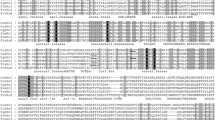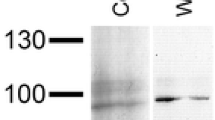Abstract
Hemocyanin is the blue respiratory protein of many arthropod species. While its structure, evolution, and physiological function have been studied in detail in Decapoda, there is little information on hemocyanins from other crustacean taxa. Here, we have investigated the hemocyanin of the peacock mantis shrimp Odontodactylus scyllarus, which belongs to the Stomatopoda (Hoplocarida). O. scyllarus hemocyanin forms a dodecamer (2 × 6-mer), which is composed of at least four distinct subunit types. We obtained the full-length cDNA sequences of three hemocyanin subunits, while a fourth cDNA was incomplete at its 5′ end. The complete full-length cDNAs of O. scyllarus hemocyanin translate into polypeptides of 650–662 amino acids, which include signal peptides of 16 or 17 amino acids. The predicted molecular masses of 73.1–75.1 kDa correspond well with the main hemolymph proteins detected by SDS-PAGE and Western blotting using various anti-hemocyanin antibodies. Phylogenetic analyses show that O. scyllarus hemocyanins belong to the β-type of malacostracan hemocyanin subunits, which diverged from the other subunits before the radiation of the malacostracan subclasses around 520 million years ago. Molecular clock analysis revealed an ancient and complex pattern of hemocyanin subunit evolution in Malacostraca and also allowed dating divergence times of malacostracan taxa.






Similar content being viewed by others
Abbreviations
- EST:
-
Expressed sequence tag
- Hc:
-
Hemocyanin
- ML:
-
Maximum likelihood
- MYA:
-
Million years ago
- PCR:
-
Polymerase chain reaction
- SDS-PAGE:
-
Sodium dodecyl sulfate-polyacrylamide gel electrophoresis
References
Averdam A, Markl J, Burmester T (2003) Subunit sequences of the 4 × 6-mer hemocyanin from the golden orb-web spider, Nephila inaurata. Eur J Biochem 270:3432–3439
Ballweber P, Markl J, Burmester T (2002) Complete hemocyanin subunit sequences of the hunting spider Cupiennius salei: recent hemocyanin remodeling in entelegyne spiders. J Biol Chem 277:14451–14457
Benton MJ, Donoghue PC (2007) Paleontological evidence to date the tree of life. Mol Biol Evol 24:26–53
Bijlholt M, van Bruggen EF (1986) A model for the architecture of the hemocyanin from the arthropod Squilla mantis (Crustacea, Stomatopoda). Eur J Biochem 155:339–344
Bridges CR (2001) Modulation of haemocyanin oxygen affinity: properties and physiological implications in a changing world. J Exp Biol 204:1021–1032
Briggs DEG, Weedon MJ, White MA (1993) Arthropoda (Crustacea excluding Ostracoda). In: Benton MJ (ed) The Fossil Record 2. Chapman & Hall, London, pp 321–342
Brusca RC, Brusca GJ (2003) Invertebrates. Sinauer Associates, Sunderland
Burmester T (1999) Identification, molecular cloning, and phylogenetic analysis of a non-respiratory pseudo-hemocyanin of Homarus americanus. J Biol Chem 274:13217–13222
Burmester T (2001) Molecular evolution of the arthropod hemocyanin superfamily. Mol Biol Evol 18:184–195
Burmester T (2002) Origin and evolution of arthropod hemocyanins and related proteins. J Comp Physiol B 172:95–107
Burmester T, Scheller K (1996) Common origin of arthropod tyrosinase, arthropod hemocyanin, insect hexamerin, and dipteran arylphorin receptor. J Mol Evol 42:713–728
Burmester T, Scheller K (1999) Ligands and receptors: common theme in insect storage protein transport. Naturwissenschaften 86:468–474
Decker H, Föll R (2000) Temperature adaptation influences the aggregation state of hemocyanin from Astacus leptodactylus. Comp Biochem Physiol A Mol Integr Physiol 127:147–154
Durstewitz G, Terwilliger NB (1997) Developmental changes in hemocyanin expression in the Dungeness crab, Cancer magister. J Biol Chem 272:4347–4350
Ertas B, von Reumont BM, Wagele JW, Misof B, Burmester T (2009) Hemocyanin suggests a close relationship of remipedia and hexapoda. Mol Biol Evol 26:2711–2718
Ferrero EA, Graziosi G, Marzari R, Mosco A (1983) Protein pattern variability of the hemolymph of mantis shrimp Squilla mantis L. (Crustacea, Stomatopoda). J Exp Zool 225:341–345
Gaykema WPJ, Hol WGJ, Vereijken JM, Soeter NM, Bak HJ, Beintema JJ (1984) 3.2 Å structure of the copper-containing, oxygen-carrying protein Panulirus interruptus haemocyanin. Nature 309:23–29
Gradstein FM, Ogg JG, Smith AG (2005) A Geologic Time Scale 2004. Cambridge University Press, Cambridge
Hagner-Holler S, Schoen A, Erker W, Marden JH, Rupprecht R, Decker H, Burmester T (2004) A respiratory hemocyanin from an insect. Proc Natl Acad Sci USA 101:871–874
Hagner-Holler S, Kusche K, Hembach A, Burmester T (2005) Biochemical and molecular characterisation of hemocyanin from the amphipod Gammarus roeseli: complex pattern of hemocyanin subunit evolution in Crustacea. J Comp Physiol B 175:445–452
Harris JR, Agutter PS (1970) A negative staining study of human erythrocyte ghosts and rat liver nuclear membranes. J Ultrastruct Res 33:219–232
Hof CHJ (1998) Fossil stomatopods (Crustacea: Malacostraca) and their phylogenetic impact. J Nat Hist 32:1567–1576
Holmes DS, Bonner J (1973) Preparation, molecular weight, base composition, and secondary structure of giant nuclear ribonucleic acid. Biochemistry 12:2330–2338
Huelsenbeck JP, Ronquist F (2001) MRBAYES: Bayesian inference of phylogenetic trees. Bioinformatics 17:754–755
Immesberger A, Burmester T (2004) Putative phenoloxidases in the tunicate Ciona intestinalis and the origin of the arthropod hemocyanin superfamily. J Comp Physiol B 174:169–180
Jaenicke E, Fraune S, May S, Irmak P, Augustin R, Meesters C, Decker H, Zimmer M (2009) Is activated hemocyanin instead of phenoloxidase involved in immune response in woodlice? Dev Comp Immunol 33:1055–1063
Katoh K, Kuma K, Toh H, Miyata T (2005) MAFFT version 5: improvement in accuracy of multiple sequence alignment. Nucleic Acids Res 33:511–518
Kusche K, Burmester T (2001) Diplopod hemocyanin sequence and the phylogenetic position of the Myriapoda. Mol Biol Evol 18:1566–1573
Kusche K, Ruhberg H, Burmester T (2002) A hemocyanin from the Onychophora and the emergence of respiratory proteins. Proc Natl Acad Sci USA 99:10545–10548
Kusche K, Hembach A, Milke C, Burmester T (2003) Molecular characterisation and evolution of the hemocyanin from the European spiny lobster, Palinurus elephas. J Comp Physiol B 173:319–325
Langley CH, Fitch WM (1974) An examination of the constancy of the rate of molecular evolution. J Mol Evol 3:161–177
Loewe R, Linzen B (1973) Hemocyanins in spiders I. Subunits and stability region of Dugesiella californicum hemocyanin. Hoppe Seylers Z Physiol Chem 354:182–188
Manfioletti G, Savoini A, Graziosi G, Ferrero EA (1985) Identification of four different subunits in the haemocyanin of the mantis shrimp, Squilla mantis (Crustacea, Stomatopoda). Ital J Zool 52:239–242
Mangum CP (1980) Respiratory function of the hemocyanins. Am Zool 20:19–38
Mangum CP (1983) Oxygen transport in blood. In: Mantel LH (ed) The biology of the Crustacea. Academic Press, New York, pp 373–429
Mangum CP (1985) Oxygen transport in invertebrates. Am J Physiol 248:505–514
Mangum CP, Joy PJ (1997) Hemocyanin subunit composition in the American lobster Homarus americanus. J Crust Biol 17:1–5
Markl J (1986) Evolution and function of structurally diverse subunits in the respiratory protein hemocyanin from arthropods. Biol Bull 171:90–115
Markl J, Decker H (1992) Molecular structure of the arthropod hemocyanins. Adv Comp Environ Physiol 13:325–376
Markl J, Hofer A, Bauer G, Markl A, Kempter B, Brenzinger M, Linzen B (1979) Subunit heterogeneity in arthropod hemocyanins: II. Crustacea. J Comp Physiol 133:167–175
Markl J, Stöcker W, Runzler R, Precht E (1986) Immunological correspondences between the hemocyanin subunits of 86 arthropods: evolution of a multigene protein family. In: Linzen B (ed) Invertebrate oxygen carriers. Springer, Heidelberg, pp 281–292
Martin JW, Davis GE (2001) An updated classification of the recent Crustacea. Natural History Museum of Los Angeles County, Los Angeles
Menze M, Hellmann N, Decker H, Grieshaber M (2001) Binding of urate and caffeine to haemocyanin analysed by isothermal titration calorimetry. J Exp Biol 204:1033–1038
Miller KI, Elderd NW, Arisaka F, van Holde KE (1977) Structure and function of hemocyanin from thalassinid shrimp. J Comp Physiol 115:171–184
Nicholas KB, Nicholas HBJ, Deerfield DWI (1997) GeneDoc: analysis and visualization of genetic variation. EMBnet NEWS 4:14
Nielsen H, Engelbrecht J, Brunak S, von Heijne G (1997) A neural network method for identification of prokaryotic and eukaryotic signal peptides and prediction of their cleavage sites. Int J Neural Syst 8:581–599
Pick C, Schneuer M, Burmester T (2009) The occurrence of hemocyanin in Hexapoda. FEBS J 276:1930–1941
Sanderson MJ (2003) r8s: inferring absolute rates of molecular evolution and divergence times in the absence of a molecular clock. Bioinformatics 19:301–302
Schönenberger N, Cox JA, Gabbiani G (1980) Evidence for hemocyanin formation in the compound eye of Squilla mantis (Crustacea, Stomatopoda). Cell Tissue Res 205:397–409
Stamatakis A (2006) RAxML-VI-HPC: maximum likelihood-based phylogenetic analyses with thousands of taxa and mixed models. Bioinformatics 22:2688–2690
Stöcker W, Raeder U, Bijlholt MMC, Wichertjes T, van Bruggen EF, Markl J (1988) The quaternary structure of four crustacean two-hexameric hemocyanins: immunocorrelation, stoichiometry, reassembly and topology of individual subunits. J Comp Physiol B 158:271–289
Terwilliger NB, Dangott L, Ryan M (1999) Cryptocyanin, a crustacean molting protein: evolutionary link with arthropod hemocyanins and insect hexamerins. Proc Natl Acad Sci USA 96:2013–2018
van Holde KE, Miller KI (1995) Hemocyanins. Adv Protein Chem 47:1–81
van Holde KE, Miller KI, Decker H (2001) Hemocyanins and invertebrate evolution. J Biol Chem 276:15563–15566
Voit R, Feldmaier-Fuchs G, Schweikardt T, Decker H, Burmester T (2000) Complete sequence of the 24-mer hemocyanin of the tarantula Eurypelma californicum. Structure and intramolecular evolution of the subunits. J Biol Chem 275:39339–39344
Volbeda A, Hol WG (1989) Crystal structure of hexameric haemocyanin from Panulirus interruptus refined at 3.2 Å resolution. J Mol Biol 209:249–279
Watling L, Hof CHJ, Schram FR (2000) The place of the Hoplocarida in the Malacostracan pantheon. J Crust Biol 20:1–11
Wills M (1997) A phylogeny of recent and fossil Crustacea derived from morphological characters. In: Fortey RA, Thomas RH (eds) Arthropod relationships. Chapman & Hall, London, pp 189–209
Wills MA, Jenner RA, Ni Dhubhghaill C (2009) Eumalacostracan evolution: conflict between three sources of data. Arthropod Syst Phylogeny 67:71–90
Acknowledgments
This work is supported by a grant of the Deutsche Forschungsgemeinschaft (Bu956/9). The nucleotide sequences reported in this paper have been submitted to the EMBL/GenBank™ Nucleotide Sequence Databases under the accession numbers FM999828 to FM999831.
Author information
Authors and Affiliations
Corresponding author
Additional information
Communicated by G. Heldmaier.
See Table 1 for abbreviations of hemocyanins.
Electronic supplementary material
Below is the link to the electronic supplementary material.
Rights and permissions
About this article
Cite this article
Scherbaum, S., Ertas, B., Gebauer, W. et al. Characterization of hemocyanin from the peacock mantis shrimp Odontodactylus scyllarus (Malacostraca:Hoplocarida). J Comp Physiol B 180, 1235–1245 (2010). https://doi.org/10.1007/s00360-010-0495-5
Received:
Revised:
Accepted:
Published:
Issue Date:
DOI: https://doi.org/10.1007/s00360-010-0495-5




